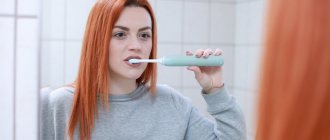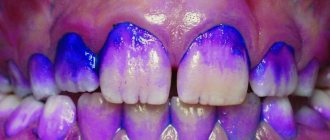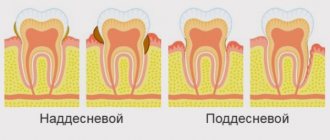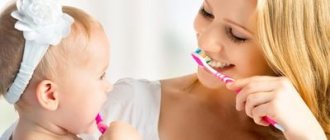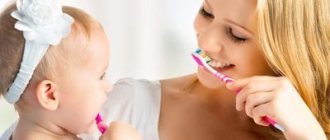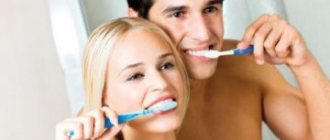Daily oral hygiene is a routine process, brought to the point of “automation”. Often we brush our teeth without thinking about the rules, the position of the brush and the direction of movement. Meanwhile, not only the aesthetic appeal of a smile, but also its health depends on how well oral hygiene is performed. Many dental problems can be avoided (prevented or eliminated) only by following the basic rules of effective teeth brushing.
Consequences of improper teeth brushing
It may surprise some, but improper brushing not only does not get rid of plaque, but can also lead to deterioration of the condition of teeth and gums. Surprising, but nevertheless, it is a fact.
The most common mistake when using a classic (manual) brush is brushing your teeth only with horizontal movements (right - left). With this method:
- the interdental spaces are not cleaned, becoming additionally clogged with plaque;
- Plaque near the gums is not removed, forming large accumulations of dirt and pathogenic microflora.
The above leads to problems such as:
- wedge-shaped defect (in its advanced form it can cause exposure of the neck and fracture of the dental crown);
- caries;
- periodontitis (inflammation of the tissues surrounding the teeth);
- inflammatory processes, bleeding gums;
- formation of tartar;
- pronounced darkening of the enamel;
- bad breath, etc.
Even when using high-quality toothpastes and brushes, the best preventative measure for the mentioned dental problems is still choosing and following the correct teeth brushing technique.
Bass method
The head of the brush with bristles is positioned at an angle of 45 degrees to the axis of the tooth, slightly pressing the ends of the bristles to the enamel and gum. Thus, the fibers penetrate into the gingival groove and interdental spaces. It is important to maintain the correct position of the brush head, because... Vertically positioned bristles damage the epithelial attachment and gingiva.
Cleaning the labial (cheek) and oral surfaces of the teeth is done with vibrating movements with a small amplitude. Chewing surfaces are cleaned with back and forth movements. This method allows you to thoroughly clean the cervical area of the molars.
Classical technique of brushing teeth (Pakhomov G.N. method)
Most Russian dentists recommend the method of brushing teeth, invented by professor of dentistry Gennady Nikolaevich Pakhomov.
Pakhomov's method G.N. is considered the most effective and consists of the following algorithm of actions:
- The dentition should be divided into 4 segments (left and right parts of the upper jaw, left and right parts of the lower jaw).
- It is advisable to start cleaning from the upper jaw from the right molars towards the front teeth. Next, brushing along the top row continues from the front teeth and ends on the left molars.
- The lower jaw is cleaned, on the contrary, from the left molars to the front ones and ends at the right molars.
- When cleaning the outer and inner surfaces of the dentition, the brush must be held horizontally. The bristles should be positioned at a 45° angle to the surface of the teeth and gums. Cleaning is carried out with sweeping movements from the gums to the edge of the tooth. For each pair of teeth, 10 such movements must be performed.
- Contaminants from the chewing side of the teeth are removed by moving the brush head back and forth (reciprocating movements). At the same time, the fibers of the brush penetrate deeply into the interdental spaces and fissures, providing high-quality cleansing.
- To clean the inner surface of the front teeth, it is more convenient to place the brush vertically. Cleaning is also carried out using sweeping movements from the gums to the edge of the tooth.
Standard method of Pokhomov G.N. allows you to thoroughly clean the oral cavity. If there are hard-to-reach areas of the dentition that are inaccessible to the toothbrush used, then it is recommended to use additional means - dental floss, irrigators, etc.
How to brush your teeth correctly!
The standard cleaning method is used by adults when cleaning themselves and children.
- Clean the front surfaces of the teeth of the upper and lower jaw. The brush is positioned at an angle of 45° at the edge of the gum and 10 sweeping movements are made towards the chewing surface, capturing 2 teeth each.
- The inner surface of the teeth is cleaned with similar sweeping movements.
- When cleaning the inner surface of the front teeth, the brush handle is placed vertically - parallel to the axis of the tooth. And they make 10 movements from the gum to the cutting edge for each individual tooth.
- The chewing surface is cleaned by making 10 reciprocating movements on each side of the jaws.
Be consistent, brush from one end of the teeth to the other in order.
The KAI teeth brushing method is used by children under 6 years of age.
- We close our teeth and smile. We begin to draw circles on the front surface of the teeth. We drew 10 pieces in front, move to the side - 10 on the right, 10 on the left.
- Open your mouth and clean the bumps and pits on your teeth forward and backward 10 times. That is, the chewing surfaces on the right and left on both jaws.
- We clean the inner surface of the teeth with sweeping movements from red to white - from the gum to the crown. 10 movements for every two teeth (the last point is not always successfully achieved by the child; one way or another, after brushing the teeth on your own, repeated brushing by adults using the standard method is necessary).
Flossing
This procedure is carried out once a day. Children under 9 years old are cleaned by their parents, and later - on their own.
- Unwind about 50 cm of floss and wrap it around your middle fingers so that 3-4 cm of thread remains between your fingers.
- Holding the floss firmly against one surface of the tooth, gently lower it through the tight interdental contact. Try not to make much effort so as not to injure your gums.
- Using an up and down motion, clean the surface of one tooth under the gum. Bring the thread until you feel it stop - this is 2-3 mm under the visible edge of the gum.
- Without removing the floss from the interdental space, brush the adjacent tooth using similar movements.
- Try to constantly move the thread to a fresh part, this way you will clean each tooth with a clean section of the thread and by the end of cleaning you will use the entire unwound section.
Flossing is carried out after brushing your teeth with a brush and toothpaste.
Brushes for cleaning interdental spaces
Used by children with orthodontic fixed structures or in the presence of wide interdental spaces.
The cleaning method is simple - you clean the interdental space with back and forth movements, while holding the brush perpendicular to the side surface of the tooth.
Additional methods of brushing teeth with a manual brush
The following two assistive techniques for brushing teeth are the most common:
Bass method
The peculiarity of this method is that it is suitable for cleaning teeth with open (exposed) root areas. The method provides not only cleaning of the teeth, but also massage of the gums.
The implementation of this technique provides for the following rules:
- The toothbrush must be held horizontally, at an angle of 45° to the surface of the tooth. In this case, half of the fibers of the toothbrush should extend beyond the gums.
- Cleaning is carried out first in a circular motion, then sweeping (from the gum to the edge of the tooth).
- To clean the internal surfaces and back (molars) teeth, the position of the brush changes to vertical.
- Cleaning the oral (palatal) and vestibular (external, from the lips and cheeks) surfaces of the tooth is performed with vibrating movements without moving the ends of the bristles.
- Chewing surfaces are cleaned with horizontal back-and-forth movements.
It is important to note that you should only use a soft toothbrush for this method.
Brushing teeth using the Bass method
There are different techniques for brushing your teeth. But the Bass method is considered one of the most effective today. The scientist who invented this method was a doctor. Dentists gave him a disappointing diagnosis of advanced gum disease and the only solution was to remove all his teeth. But Dr. Bass did not despair and instead turned to science.
He began to take swabs from his mouth, study the microflora, count the number of bacteria that remain in the oral cavity after brushing his teeth with various methods. He was looking for the most effective method. And I found him! Bottom line: Dr. Bass lived to a ripe old age with all his teeth intact.
The main rules for brushing teeth using the Bass method:
- The toothbrush must be soft and have plenty of bristles.
- Avoid rushing during hygiene! Brushing with a toothbrush should last from 3 to 5 minutes or more - everything is individual and depends on the person’s skills, the number of teeth and the presence of any structures in the oral cavity
- You need to brush your teeth at least 2 times a day - once every 12 hours!
Standard method (Pakhomov G.N.)
The dentition is conventionally divided into several segments (on each side there are molars, premolars, incisors with canines - 6 in total). Sequentially clean the labial (buccal), oral, and chewing surfaces of the teeth of one segment, then move on to the other. Teeth brushing begins with the right upper molars. In the lower jaw, start with the left molars.
The labial (cheek) and oral surfaces of the teeth are cleaned with “sweeping” movements. The head of the brush should be directed at an angle of 45 degrees to the surface of the gums and teeth. Using “sweeping” movements towards the edge of the tooth crown, plaque is removed from the gums, gingival grooves, tooth surfaces and, partially, from the interdental spaces. Next, the brush is used in several reciprocating and circular movements. Chewing surfaces are cleaned with reciprocating and circular movements of a parallel brush.
For all methods, it is important to adhere to the following rules:
- Teeth should be brushed regularly, at least 2 times a day;
- Brushing your teeth should take at least 2 minutes;
- You should not use a worn-out toothbrush: frayed bristles injure your gums and are completely ineffective at cleaning your teeth. In addition, bacteria remain on the bristles, which increases the risk of developing inflammatory diseases of the oral mucosa;
- You should change your toothbrush every two to three months;
- use a suitable toothpaste recommended by your doctor;
- The toothbrush should be stored open (in a glass, working part up), and the case should only be used during transportation.
Other ways to brush your teeth
The best way to brush your teeth is the one that's right for you.
There are different techniques for removing contaminants. Some of them are recommended for people with various pathologies, others have already lost their relevance and are needed only for information.
Leonardo
The technique was invented in the mid-20th century. According to it, the brush is placed perpendicular to the tooth surface and several vertical movements are made up and down. After processing the back and front sides, the jaws should be opened and the chewing teeth should be cleaned. They do this with standard horizontal actions.
The Leonardo method is suitable for people with gum disease, since they are not affected during the treatment. The method is suitable for children, but you need to ensure that the procedure is performed correctly.
Bassa
This technique is suitable for adults; it is difficult for children to ensure the correct position of the brush during the process. If the gums are positioned incorrectly, they become injured, bleed, and become inflamed.
It's better to use a small brush. It is placed at an angle of 45° to the transverse dental axis and produces vibrating movements. The bristles extend into the interdental spaces (partially) - this is called the outer groove position.
The head is moved gradually from one place to another, cleaning them from different sides. After this, alternately making forward and backward movements, treat the chewing surfaces.
The Bass method helps to fully clean the spaces between the teeth and is suitable for people with a healthy oral cavity and periodontitis, but in case of gum inflammation, it is better to refrain from using it.
Charter
The technique appeared at the beginning of the 20th century. The essence is to position the brush at an angle of 45° relative to the dental axis, the bristles partially extend into the interdental spaces (external groove position).
The movements are circular, allowing maximum penetration into hard-to-reach places. The repetition rate in one place is 3-4. After this, the brush is moved and another group of dental units is cleaned. Chewing surfaces are processed using back and forth movements.
The technique is gentle and suitable for gum massage of patients undergoing treatment for periodontal disease. The Charter technique involves preliminary removal of plaque with ultrasound, since it is not able to completely clean the oral cavity.
Rate
The Reite method was invented in the 70s of the 20th century. The brush is located parallel to the tooth surface at the gingival edge; during the rolling movement of the head downwards, it is placed at a right angle. This is how they clean the elements from the back and front, after which they proceed to the chewing side. It is processed with horizontal movements. The technique is quite simple, suitable for children, but is considered outdated.
Fonesa
The technique was invented by the American dentist Alfred Fones, who is considered one of the founders of hygienic dentistry.
For this method of hygienic cleaning, the teeth should be closed perpendicular to each other. The Fones technique is suitable for people without periodontal and gum pathologies. The brush is placed perpendicular to the tooth surface and cleaned alternately with circular movements (3-4 repetitions).
After this, the jaws open and proceed to the chewing surfaces. They are cleaned using standard back and forth movements.
Stillman
The Stillman technique was invented in the 30s of the last century. The essence of the method is to tightly position the head at the edge of the gum, until the latter acquires an anemic appearance. The brush is used to perform gentle rotational actions. They are done until the normal color of the soft tissues is restored. This applies to the front side.
When cleaning the rear brush, place it perpendicularly and carry out sweeping actions. The chewing sides are treated using back and forth movements.
Smith-Bell
The technique was invented in the mid-20th century. To remove dirt, the brush should be positioned perpendicular to the chewing side. The movements of the head seem to follow the path of food while chewing it. The brush is pressed and rotated, while at the same time it is moved over the entire surface of the tooth. This way the entire oral cavity is cleaned.
POSSIBLE DIFFICULTIES
Sometimes teaching a child to brush their teeth is not as easy as we would like. The following difficulties are possible.
- The baby resists the penetration of the brush into his oral cavity and perceives it clearly negatively. In this case, parents will have to be patient, but persistent. You can buy a bright, beautiful brush, which at first will be perceived as a toy, and also entertain the baby with rhymes and games, trying to evoke positive emotions in him.
- The child may find it uncomfortable to hold the brush. In this case, training (“brush the teeth” of dolls and other toys), as well as classes to develop fine motor skills, will help.
- Children may experience discomfort due to the fact that very rough bristles damage their enamel, in this situation they should replace the brush with a softer one.
It is also important for parents to keep their baby's brush clean, so they should wash it at least once a week. Silicone and polymer models should not be boiled or doused with boiling water; just wash them thoroughly with soap and then let them dry. The service life of the instrument is no more than 2-3 months, however, if the baby has suffered from an infectious disease, then replacement must be made immediately. Also, if the bristles begin to spread in different directions due to overly conscientious cleaning, then the product must be replaced.

